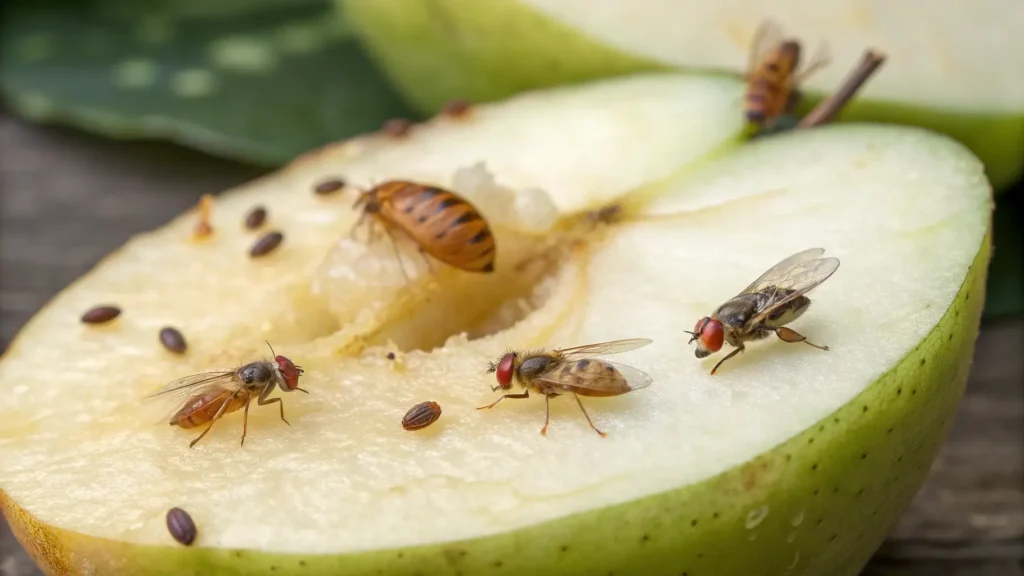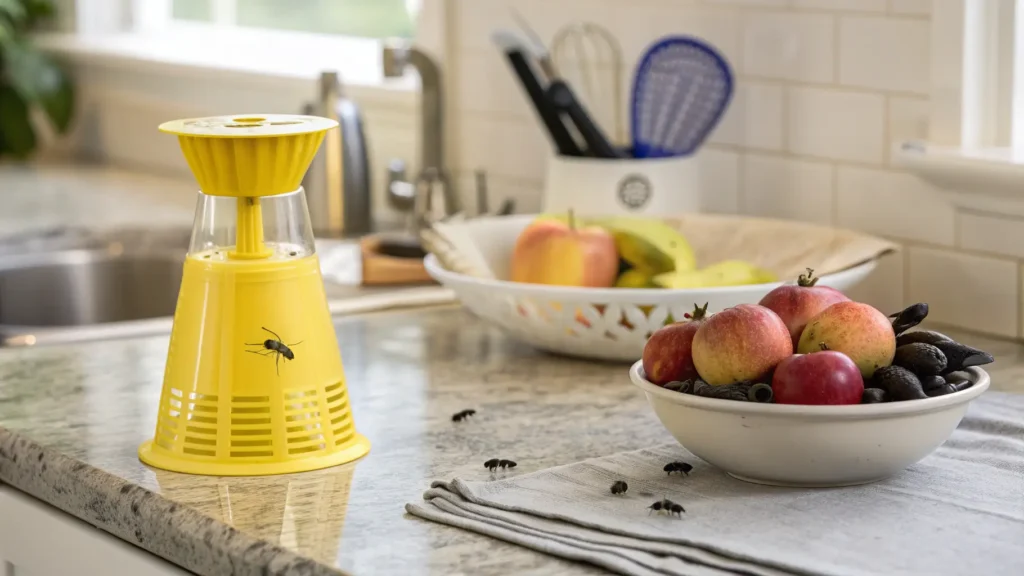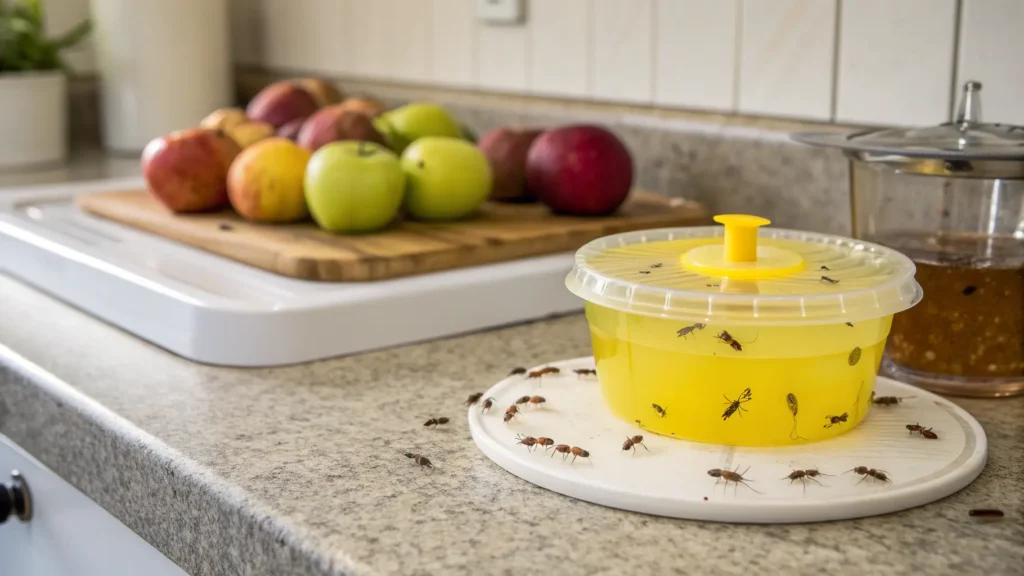Few household pests are as universally frustrating as the fruit fly. One minute your kitchen is clean, the next, a seemingly endless swarm of tiny, buzzing nuisances has descended upon your ripening fruit or lingering crumbs. These prolific invaders can lay up to 500 eggs in their short lifespan, making quick action essential. Fortunately, you don’t need harsh chemicals or expensive gadgets to reclaim your space. The best homemade fruit fly trap is often found using simple, readily available ingredients right in your pantry.
This comprehensive guide will arm you with the knowledge and tools to effectively eliminate these persistent pests. We’ll explore why homemade solutions are often your most effective, cost-efficient, and non-toxic defense, setting you up for success in getting rid of fruit flies for good.
TABLE OF CONTENTS
Stop the Swarm: Why Homemade Fruit Fly Traps Are Your Best Defense
The sudden appearance of a fruit fly infestation can feel overwhelming. These tiny invaders seem to multiply overnight, turning a calm kitchen into a buzzing battleground. The good news? Combatting them doesn’t require a degree in entomology or an arsenal of harsh chemicals. Homemade fruit fly traps offer a powerful, accessible, and environmentally friendly solution.
Opting for a DIY approach provides several key benefits:
- Cost-Effective: Most homemade traps rely on ingredients you likely already have, saving you money on commercial products.
- Non-Toxic: You avoid introducing potentially harmful chemicals into your home, making these solutions safe for families and pets. This aligns with the desire for safe pest control.
- Accessible Ingredients: Forget special trips to hardware stores; your pantry is often your best defense.
- Proven Effectiveness: Simple household items, when combined correctly, create incredibly potent traps that target what fruit flies crave most.
By understanding the enemy and deploying the right homemade fruit fly trap, you can quickly curb the infestation and restore peace to your kitchen.
Understanding Your Enemy: The Fruit Fly Life Cycle and Attraction
To truly master getting rid of fruit flies, you must first understand them. These tiny creatures, often mistaken for gnats, have a fascinatingly fast life cycle that explains their rapid population growth. A female fruit fly can lay hundreds of eggs, usually on fermenting fruit or in moist organic matter, which hatch into larvae within 24-30 hours. These larvae feed for several days before pupating, and then emerge as adult flies just a few days later, ready to mate and continue the cycle. The entire process can take as little as 8-10 days, meaning a small problem can quickly become a significant fruit fly infestation.

What Attracts Them?
Fruit flies are primarily drawn to:
- Fermenting Fruits and Vegetables: Their namesake attraction. Overripe bananas, apples, and tomatoes are prime targets.
- Sugary Liquids: Spilled juice, soda, wine, beer, and even the residue in empty bottles.
- Moist Organic Debris: This includes food scraps in trash cans, compost bins, dirty dish rags, and even drains.
- Fermenting Grains: Old bread or cereals left exposed can also be appealing.
These pests typically enter your home through open windows or doors, on produce brought in from the grocery store, or even through small cracks and crevices. Knowing their attractants is the first step in effective fruit fly prevention and trapping.
The #1 Champion Trap: Apple Cider Vinegar (ACV) & Dish Soap Method
When people ask, “what is the best homemade fruit fly trap?”, the apple cider vinegar and dish soap method consistently rises to the top. This simple yet incredibly effective DIY fruit fly killer leverages the flies’ natural attraction to fermented scents while ensuring their demise.
Ingredients You’ll Need:
- Apple Cider Vinegar (ACV): The primary attractant. Its sweet, fermented aroma is irresistible to fruit flies. White vinegar is not effective.
- Dish Soap: Just a few drops. This is the secret weapon, breaking the surface tension of the ACV so flies can’t simply land and fly away.
- Container: A small bowl, jar, or even an empty bottle.
- Plastic Wrap (optional, for covering the container)
- Rubber Band (optional, for securing plastic wrap)
- Toothpick or Fork (optional, for poking holes in plastic wrap)
Step-by-Step Instructions:
- Pour the ACV: Fill your chosen container with about an inch or two of apple cider vinegar.
- Add Dish Soap: Add 2-3 drops of liquid dish soap directly into the ACV. Do not stir vigorously, as you want the soap to distribute gradually on the surface.
- Choose Your Cover Method:
- Plastic Wrap Method: Cover the top of the container tightly with plastic wrap and secure it with a rubber band. Using a toothpick or fork, poke several small holes (about 1/8 inch wide) into the plastic wrap. The flies can get in, but struggle to find their way out.
- Funnel Method (No Plastic Wrap): Roll a piece of paper into a cone shape, ensuring the narrow end has a small opening (again, about 1/8 inch). Place the wide end into the container, creating a funnel. This allows flies in but makes escape difficult.
- Optimal Placement: Place the trap near the source of the fruit flies – typically your fruit bowl, kitchen sink, or trash can.
Get Rid of Fruit Flies Fast – Easy Fruit Fly Trap
Why It Works:
The pungent, sweet smell of the apple cider vinegar acts as a powerful lure, drawing the fruit flies directly to the trap. Once they attempt to land on the liquid, the dish soap works its magic. Without the soap, the surface tension of the liquid would allow the tiny flies to simply walk on it or drink and fly off. The soap breaks this tension, causing them to sink and drown.
For maximum effectiveness, set up multiple homemade fruit fly traps in different problem areas.
Troubleshooting Your ACV Trap: Common Issues and Solutions
Even the #1 champion trap can sometimes seem to fail. Don’t despair! Most issues are easily remedied. Here’s a quick fix checklist for your ACV trap:
- Flies Aren’t Going In:
- Is the ACV Fresh? Old, less fragrant vinegar won’t be as appealing. Use fresh apple cider vinegar.
- Enough Dish Soap? Ensure 2-3 drops of soap are well-distributed on the surface to break tension.
- Better Attractant Nearby? Check for other, more appealing food sources (overripe fruit, spills). Remove competing attractants.
- Trap Placement: Is it in a high-traffic fruit fly area? Move it closer to where you see the most activity.
- Flies Are Escaping:
- Hole Size: Are the holes in your plastic wrap too large? They should be just big enough for a fly to enter, but not easily exit.
- Proper Seal: Is the plastic wrap tightly sealed around the container? Any gaps provide an escape route.
- Funnel Opening: If using the funnel method, is the bottom opening too wide or the angle too shallow?
- Trap Placement Issues:
- Avoid placing traps directly under strong air currents from fans or vents, as this can disperse the attractant smell.
- Place them at counter height, where fruit flies typically congregate.
By reviewing these points, you can quickly optimize your homemade fruit fly trap for maximum success.

Other Highly Effective Homemade Fruit Fly Traps
While the ACV and dish soap method is a powerhouse, other excellent homemade fruit fly traps can be effective, especially if you lack apple cider vinegar or want to try alternative baits. These methods also utilize common household items to create potent natural insect traps.
Here’s a comparison of some popular alternatives:
| Trap Type | Ingredients | Instructions | Rationale |
|---|---|---|---|
| Wine/Beer Trap | Old wine (red or white), beer, container, plastic wrap/funnel (optional) | Pour an inch or two of leftover wine or beer into a container. For increased effectiveness, add a few drops of dish soap. Cover with plastic wrap with holes, or use a paper funnel. | Fruit flies are highly attracted to the fermented alcohol and yeast in wine and beer. The dish soap aids in drowning. |
| Overripe Fruit Trap | Piece of overripe fruit (banana, apple), container, plastic wrap/funnel, dish soap (optional) | Place a small piece of heavily overripe (or slightly rotting) fruit in the bottom of a container. Add a few drops of dish soap for better results. Cover with plastic wrap and poke small holes, or use a paper funnel. | Mimics their natural food source. The strong scent of decaying fruit is an irresistible attractant. |
| Milk, Sugar, Pepper Trap | 1 cup milk, 1/4 cup sugar, 2 oz ground black pepper, shallow bowl | Combine milk, sugar, and ground black pepper in a shallow bowl. Simmer for 5-10 minutes. Once cooled, pour into a shallow dish. | Less common but effective. Fruit flies are drawn to the sweet scent, and the pepper is thought to have a paralyzing effect. |
Each of these DIY fruit fly killer options capitalizes on different attractants while maintaining the core principle of luring and trapping. Experiment to see which works best for your specific fruit fly problem. For more specialized methods, you might explore
Beyond the Trap: Essential Fruit Fly Prevention Strategies
Trapping fruit flies is a crucial reactive measure, but true victory lies in proactive fruit fly prevention. By understanding and eliminating their breeding grounds and food sources, you can significantly reduce the chances of a future fruit fly infestation. This approach is key to achieving long-term freedom from these kitchen pests.
Here’s your comprehensive prevention checklist:
- Immediate Cleanup:
- Wipe Up Spills: Any sugary or alcoholic spills, even small drops, are a magnet.
- Clean Dishes Promptly: Don’t leave dirty dishes in the sink, especially those with food residue.
- Proper Food Storage:
- Refrigerate Ripening Fruit: Once fruit begins to ripen, store it in the refrigerator. This significantly slows the fermentation process.
- Sealed Containers: Keep all fruits, vegetables, and other perishables in airtight containers.
- Compost Control: If you compost, keep your compost bin sealed and empty it frequently.
- Trash Management:
- Regular Emptying: Empty kitchen trash cans daily, especially if they contain food scraps.
- Lined Bins: Use trash bags and keep your trash can lid tightly closed.
- Clean Bins: Periodically wash your trash can with hot, soapy water.
- Drain and Disposal Care:
- Weekly Flush: Fruit flies can breed in the organic film that lines drains and garbage disposals. Pour a solution of boiling water, followed by a cup of baking soda, and then a cup of white vinegar down drains. Let it sit for 30 minutes, then flush with more hot water.
- Use Disposals Regularly: Run your garbage disposal often to grind up any lingering food particles.
- Houseplant Maintenance:
- Avoid Overwatering: Fungus gnats (often confused with fruit flies) and fruit flies can be attracted to overly moist soil and decaying plant matter. Allow soil to dry out between waterings.
- Remove Fallen Fruit/Leaves: Promptly remove any fallen fruit or leaves from potted plants.
- Inspect Groceries:
- Before bringing produce into your home, inspect it for signs of fruit flies or their eggs. Wash fruits and vegetables thoroughly upon arrival.
When DIY Isn’t Enough: Advanced Solutions & Professional Help
While homemade fruit fly traps and diligent prevention are highly effective, there are rare instances where a severe fruit fly infestation might persist or prove particularly stubborn. In such cases, it’s helpful to know when to consider more advanced solutions or even professional intervention.
Advanced DIY Tools:
- Sticky Traps: Commercial sticky traps, often yellow, are designed to attract and trap various flying insects. While not a primary solution for a large infestation, they can help monitor population levels and catch stragglers. Ensure they are placed safely away from food.
- Commercial Sprays (Use with Caution): A last resort for DIYers, over-the-counter insecticide sprays can be used, but always follow package directions precisely. Prioritize non-toxic methods whenever possible, especially in food preparation areas.
Professional pest control services have access to specialized tools and treatments that can pinpoint hidden breeding grounds and apply targeted solutions safely. When choosing a service, look for licensed and reputable companies that offer integrated pest management (IPM) approaches, which prioritize environmentally sensitive methods. They can help you achieve effective and safe pest control.

Homemade Fruit Fly Traps: Your Burning Questions Answered (FAQ)
Here are answers to some of the most common questions about fruit flies and how to tackle them:
Q: How long do homemade fruit fly traps take to work? A: You should start seeing results within a few hours, with significant reductions in the fruit fly population within 12-24 hours. Peak effectiveness often occurs in the first 2-3 days.
Q: How often should I change my fruit fly trap? A: For best results, change your homemade fruit fly trap every 2-3 days, or sooner if it becomes heavily populated with flies or the attractant liquid starts to evaporate or lose its potency. Fresh attractant is key.
Q: Are fruit flies harmful? A: Fruit flies are generally considered nuisance pests and are not known to bite humans or transmit diseases directly. However, they can contaminate food surfaces and can be very unhygienic, especially if they are breeding on decaying matter.
Q: Can fruit flies lay eggs in drains? A: Yes, absolutely. Drains, especially those with a buildup of organic matter (food particles, soap scum, hair), are prime breeding grounds for fruit flies (and drain flies, which look similar but are hairier). Regular cleaning of drains is a critical prevention step.
Q: What’s the best time of year for fruit flies? A: Fruit flies are most prevalent during warmer months, typically late summer and early fall, when fruits and vegetables are ripening and being harvested. However, they can be a year-round problem indoors if conditions are right.
Q: What attracts fruit flies the most? A: Fermenting sugary substances are the biggest draw. This includes overripe fruits, spilled juice, wine, beer, and sugary residues in bottles or drains.
Q: Do homemade fruit fly traps work? A: Yes, homemade fruit fly traps are highly effective due to their ability to leverage the flies’ strong attraction to fermented scents. When combined with prevention strategies, they can be a powerful tool for eliminating infestations.
Q: How long do fruit flies live? A: The lifespan of an adult fruit fly is relatively short, typically around 8-15 days. However, given their rapid reproduction rate, a continuous cycle means new generations are constantly emerging, making consistent trapping and prevention essential.
Q: What’s the difference between gnats vs fruit flies? A: While often confused, fruit flies and gnats are different. Fruit flies (Drosophila melanogaster) are typically tan/orange with bright red eyes, attracted to fermenting produce. Fungus gnats are usually darker, smaller, and attracted to moist soil in houseplants. Drain flies are hairy and dark, attracted to organic matter in drains.
Conclusion: Reclaim Your Kitchen with the Best Homemade Fruit Fly Trap
Dealing with a fruit fly infestation can be incredibly frustrating, but you now possess the ultimate toolkit to effectively combat these persistent pests. By understanding their life cycle, diligently applying the #1 champion apple cider vinegar and dish soap trap, and implementing robust prevention strategies, you can reclaim your kitchen and enjoy a fruit fly-free home. Remember, consistency is key: regularly refresh your homemade fruit fly traps and maintain vigilant cleanliness. Don’t let these tiny invaders take over; empower yourself with these simple, cost-effective solutions and experience the satisfaction of a truly pest-free environment. Your journey to getting rid of fruit flies starts now!
